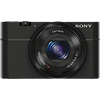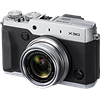Main
Model
Price
Advantages
launch
Announced
Body type
Camera subcategory
Sensor
Effective pixels
Max resolution
Sensor size
Sensor type
Processor
Image ratio w:h
Other resolutions
Sensor photo detectors
Image
ISO
White balance presets
Custom white balance
Image stabilization
Uncompressed format
JPEG quality levels
Photography features
Minimum shutter speed
Maximum shutter speed
Aperture priority
Shutter priority
Manual exposure mode
Subject / scene modes
Built-in flash
External flash
Flash modes
Continuous drive
Self-timer
Metering modes
Exposure compensation
AE Bracketing
WB Bracketing
Flash range
Screen / viewfinder
Articulated LCD
Screen size
Screen dots
Touch screen
Screen type
Live view
Viewfinder type
Viewfinder coverage
Viewfinder magnification
Viewfinder resolution
Videography features
Resolutions
File Format
Microphone
Speaker
Optics & Focus
Focal length (equiv.)
Optical zoom
Maximum aperture
Autofocus
Digital zoom
Manual focus
Macro focus range
Number of focus points
Normal focus range
Physical
Weight (inc. batteries)
Dimensions
Environmentally sealed
Battery
Battery details
Battery Life (CIPA)
Storage
Storage types
Connectivity
USB
HDMI
Wireless
Remote control
Microphone port
Headphone port
Wireless notes
Other features
Orientation sensor
Timelapse recording
GPS
Samples
Videos
Summary
The Cyber-shot DSC-RX100 maximum resolution of 5472 x 3648 pixels (20 megapixels) is better than the X30 maximum resolution of 4000 x 3000 pixels (12 megapixels). The Cyber-shot DSC-RX100 is produced with larger sensor compared to the X30: 1 (13.2 x 8.8 mm) versus 2/3' (8.8 x 6.6 mm). This is very important difference between these models because large sensor allows the photographer to take photos of the more professional quality. The Cyber-shot DSC-RX100 offers a wider ISO range of 100-25600 in compare with 100-12800 ISO range of the X30. This ISO range allow the camera owner to take better photos in more difficult situations. The Cyber-shot DSC-RX100 has more number of white balance presets - 9. This option gives the photographer more control over colour. The Sony Cyber-shot DSC-RX100 has better 14x digital zoom. The Fujifilm X30 offers better 4x optical zoom. The X30 has more focus points in compare with the Cyber-shot DSC-RX100: 49 vs 25. More focus points means more convenience while attempting to focus on objects that are not centred.
The Fujifilm X30 is equipped with tilting LCD that will allow the photographer to make images from any odd angle. The Cyber-shot DSC-RX100 screen is better as it has more screen dots 1,228,800 in comparison to 920,000 dots of the X30 screen. The higher dot count screen is better for reviewing pictures on your camera.
The Fujifilm X30 supports external flash. It provides superior control over the exposure and lighting of the object in low light or in bright light situations when you need to fill-flash. The Fujifilm X30 is produced with built-in Wi-Fi that will help the camera owner to transfer photos wirelessly from a camera to a computer. The X30 battery life is better than the Cyber-shot DSC-RX100 battery life. According to CIPA standards you will be able to produce 470 photos with the X30 and only 330 with the Cyber-shot DSC-RX100. The Sony Cyber-shot DSC-RX100 weighs 240g which is 183g less than the weight of the Fujifilm X30.
The Fujifilm X30 has 10 advantages and the Cyber-shot DSC-RX100 only 8 so the X30 will be the best choice. Get the list of the best offers on Amazon.


